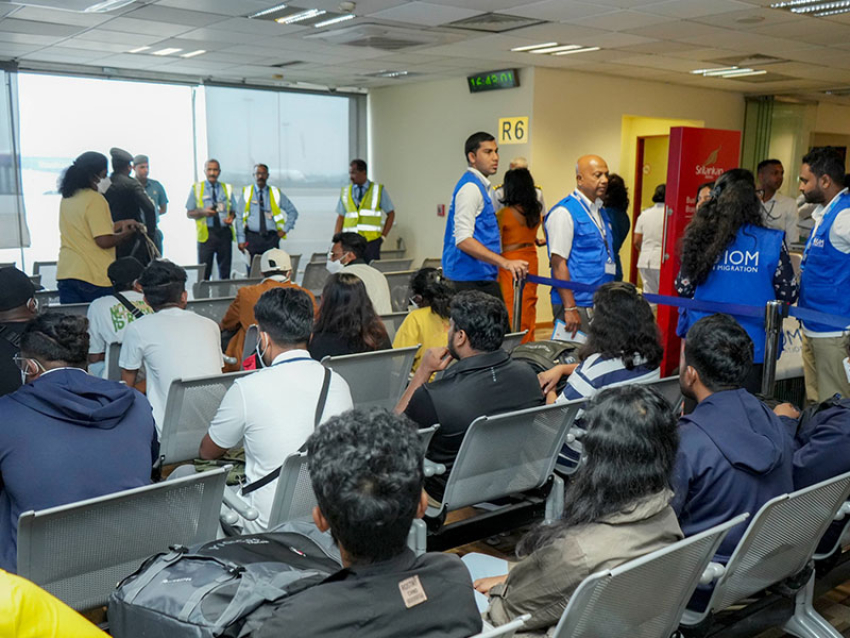The average bicycle travels thousands of miles before its very first ride out.Once a local activity, creating a bicycle now links factories, workers and craftspeople in all corners of the world.Most of us remember the day the training wheels came off: learning to balance our weight on two tyres as we propelled ourselves forward, out of the driveway and onto the street. That shared experience was, for more than a hundred years, a very local story: bicycles were once almost exclusively manufactured, assembled and sold within an individual country, perhaps within a single region.
Take the UK, 50 years ago – when bottom brackets, cranksets, sprockets, handlebars, shifters, dustcaps and gussets might have all come from a single factory in Nottingham. They would often be sold in a shop nearby and ridden perhaps no further than a few miles from home.
Today, that picture is very, very different. The process of producing a typical bicycle has been divided up and shared out among workers and craftspeople from Asia to Europe. In doing so, this once small-scale trade has become a highly integrated feat of international collaboration.
The result is a global industry worth $45bn (£36bn), with more than 100 million bicycles produced in the world each year. And the bicycle industry confers benefits beyond isolated fields like transport or environmental policy: industrial design, employment, health and social policy all get a boost from bicycle production.
Bikes are used every day and on every inhabited continent, in the most affluent nations as well as developing countries. Even in today’s high-tech age, their production outpaces that of cars or computers. As pollution rises and the cost of fossil fuels continues to climb, cycling is often the most flexible and sustainable method of transport.
From aptly named “boneshakers”, to penny-farthings, to low-slung recumbent bikes, this centuries-old invention is, in many ways, the vehicle of the future.
ADVERTISEMENT
From A to B
The “dandy horse”, invented by the German nobleman Karl von Drais in 1817, was a far cry from our modern bicycle. This clunky wooden prototype didn’t include a chain, brakes or pedals; instead, riders propelled the frame forward by pushing off from the ground with their feet. While the von Drais’ invention only enjoyed a brief stint in the spotlight before falling out of fashion, his early model inspired others in Europe to improve it.
During the 1860s, innovations in design – ball-bearing hubs, metal-spoked wheels, solid rubber tyres and a lever-operated, four-speed gearshift – allowed for more sophisticated and efficient models. Fast forward a century, and modern materials like steel, aluminum alloy and carbon meant light-weight bicycles with increased strength, rigidity and durability.
Today, the target has shifted once again, and bike manufacturers are chiefly concerned with speed. “Weight used to be the priority,” says Maurizio Bellin, general manager of component manufacturer Full Speed Ahead Europe. “Now, we are focused on improving aerodynamics.”
This switch in focus came as soon as the Union Cycliste Internationale – currently the most rigorous standard for safety in the bicycle industry – limited a bicycle’s minimum weight to 6.8kg (15lb) for professional riders. Manufacturers soon found new goals besides velocity, such as adapting tyres to be more resilient on gravel or dirt roads.
These new models in particular depend upon a multi-faceted, geographically dynamic system of production, meaning a bicycle might travel thousands of miles by air and sea before its tyres ever hit the ground.
As materials sciences allowed for technological advances, and because places like the United States and UK lacked major facilities for carbon fibre, production of high-end bike parts gradually moved overseas. In the 1990s, big companies began to produce frames for low-end bikes in places like Taiwan and then assemble them in China, before finally shipping them elsewhere.
Cheaper raw material and labour costs mean Asia has become the de-facto centre of global bike production. Consider that only half a million bicycles are produced each year in the US (0.5% of world production), while China, India and Taiwan are the top three producers of bicycles and bike parts, testament to a complex and fragmented industry with truly global reach. A bike that is built from parts made in Taiwan may be assembled in Europe and then shipped on to destinations as far-flung as the US, South Africa or Brazil.
“It’s a very integrated world,” says Will Butler-Adams, managing director of Brompton Bikes. “We still rely on a diverse global supply chain: rims from Belgium, titanium from China, metal from Taiwan, hub gears from America. We are buying raw materials from one market and selling them back to [that] same [market].”
In some sense, this diversification enables manufacturers to maintain consistency in their parts and exert control over their raw materials, while also spurring economic development in places far from home. Factory workers in these cities are guaranteed a steady income, while internal trade and return sale of bicycle parts means increased access for local inhabitants.
00:00 / 00:00
00:00 / 00:00
Getting people on bikes depends on more than just growth in manufacturing and the availability of bikes. A culture of cycling and urban planning that welcomes bike users is also essential. Hence, the non-profit BYCS launched its “bicycle mayors” scheme, aiming to connect cyclists, city councils and urban planners in major cities around the world.
Firoza Suresh is the first bicycle mayor of Mumbai, a city well known for its hectic and relentless traffic. But Suresh is used to challenges; at college, she was the only girl who travelled in on a bicycle. “We didn’t have a bicycle stand in my college,” she says. But Suresh’s enthusiasm soon caught on among her peers, and the college had to adapt. “Because so many people started cycling then the college decided they needed a cycle stand.”
Today, much of Suresh’s work as bicycle mayor depends on cooperation between government officials to establish and maintain public services such as bike lanes, bike shares, and road safety signage. Her initiative, Smart Commute, aims to get half the city’s population to commute to work by bicycle by 2030.
“Policy plays a huge role in bike safety and whether or not people will choose to bike,” says Morgan Lommele, director of state policy at People for Bikes, an industry coalition based in Colorado, US. “Cycling takes place on public property, so cyclists need a better relationship with mayors and public officials.”
Despite the ubiquity of bicycles, many cities simply aren’t equipped with the infrastructure to encourage cycling. That may be changing: Lommele’s organisation works to improve road safety, while bike-share programmes in cities like Chicago and Mexico City help people make connections between public transport and their end destinations.
Another way to join the dots across the urban landscape is to change the design of the bike itself. A niche market has developed in portable cycles, dominated by the Brompton bike. This folding two-wheeler effectively turns into a briefcase: dubbed the “Swiss Army knife of bicycles”, commuters can take their Brompton on the train or in the back of a cab, and store it under their desk at work.
“There’s nothing normal about a Brompton,” says Butler-Adams. “Every part is unique.” The company designed all 1,200 parts that make up its signature product – including the wheels, brake calipers and the robust mechanisms which transform this machine into a pocket bicycle.
Marketed as a top-end commuter bike, the Brompton is exported to 47 countries. But a bicycle that costs anywhere from $800-3,500 (£640-2,800) will always be a luxury good. When it comes to the two billion bikes currently in use around the world, many are freewheel, single-speed workhorses built to carry out essential daily activities: food delivery, rides to school, work or hospitals.
00:00 / 00:00
ADVERTISEMENT
Full cycle
The Brompton bike is one of several brands bucking the wider trend in manufacturing. Many bicycle components, including drivetrains, derailleurs and brakes, continue to be mostly manufactured in Asia, but – after decades of offshoring – some brands are returning to local roots. As overseas costs rise and brands note the value of local production, these companies have come full circle, prioritising local goods and operations transparency.
“Reshoring production to Europe is happening on a small scale,” says Jan-Willem van Schaik, editor-in-chief of Bike Europe, one of the foremost authorities on consumer trends in the biking industry. “Eastern European countries like the Czech Republic and Bulgaria are now focused on the assembly of bicycles and frame production.”
Consider Bulgaria’s industry leader, Maxcom, which has seized growth opportunities with its locally produced model, Sprint. Not only does Bulgaria export bicycles to Germany and France, but the country’s number of bicycle users has also risen, perhaps because local production spurs sales at home.
Grassroots production also helps manufacturers work toward fair labour practices and sustainability. For instance, Brompton’s “Made in London” slogan has popularised the bicycle as a uniquely English brand, and provides hundreds of jobs to brazers (the craftsmen who assemble frames) in its west London factory.
And while Full Speed Ahead still manufactures its bicycle components in Taiwan, everything from rim design to wind-tunnel testing to 3D modelling takes place in either Seattle or Milan, with strict environmental regulations for each stage of production. “You can see A to Z in one building, before we ship everything to Italy,” says Bellin.
00:00 / 00:00
The supply chain to create bicycles might have dispersed around the world, but the overall nature of the bicycle itself has remained virtually unchanged for the past 100 years. Sure, a triathalon model might be equipped with “wind-cheating” technology, a BMX road bike might have stainless steel chainstays and special tyre treads, but the average two-wheeler looks – and functions – much the same way as it has for decades. That is, up until the advent of the e-bike.
An electric bicycle still requires peddling, but riders get assistance from a small, battery-powered motor. What the iPhone was to cell phones, the e-bike may be to the bicycle industry. It promises an alternative to emission-spewing vehicles, a means to encourage new ridership, and a way to revolutionise cities. The e-bike can travel up to 45km/h (28mph) potentially replacing fossil-fuel-powered mopeds and motorcycles, with implications not just for recreation but possibly even the daily commute as well.
“I do see a shift in transportation cycling thanks to e-bikes,” says People for Bikes’ Lommele. “The e-bike market is growing 75% each year, and those are mostly new riders.”
That shift correlates to a reduction in carbon emissions, an increase in the proportion of people cycling in the world’s biggest cities, and ultimately could go a long way to fulfilling ambitious sustainability goals. “These grand ambitions put the bicycle industry at the core of sustainable development,” says van Schaik.
According to a report by Markets and Markets, the global e-bike market was estimated at $21.1bn (£16.9bn) in 2018 and projected to reach $38.6bn (£30.9bn) by 2025. “In two of Europe’s main markets, Germany and the Netherlands, e-bikes have been embraced by the consumer,” says van Schaik. “Sales increased spectacularly in 2018.”
The bicycle is arguably the most versatile vehicle out there: flexible, cheap, low-carbon and healthy. If cycling were seen as essential to city design, it could improve safety and sustainability for cyclists and non-cyclists alike. Forward-thinking urban planners and policymakers are already recognising cycling as a serious mode of transportation, on par with buses and cars.
In the future that might mean sensors that gather data on conditions of urban bike paths and the most heavily-used routes become commonplace, along with improved helmet design and smart street signs for cyclists at intersections.
If people like cycle mayor Suresh get their way, zipping past the heavy traffic of a metropolis like Mumbai might actually be as easy as, well, riding a bike.




















